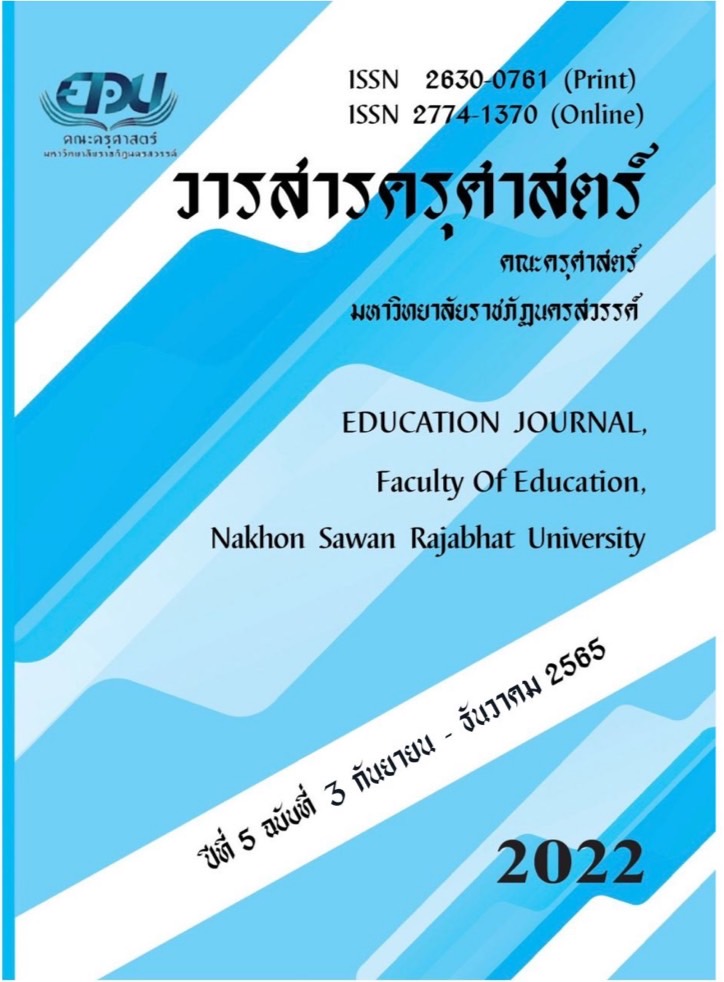A Study of Mathematical Misconception About the Geometry of 2nd Year Students in Mathematics, Faculty of Education Nakhonsawan Rajabhat University
Main Article Content
Abstract
This research aimed to study 1) compare the mean between male and female students of the geometric concept test results 2) study the misconceptions about the geometry classified by content issue and 3) study the misconceptions about the geometry classified by misconceptions characters. This is a quantitative research and study population was 32 second-year mathematics students. Using the geometric concept test, 30 items were used with the following topics: relational dimensions, parallelism, geometry, angles, line segments, midpoints, distances, slopes, circles, ellipses, parabola and hyperbola. Data analysis by percentage and average number of students who answered incorrectly in each item of the geometric concept test. The research results were found as follows;
1) misconceptions about the geometry that male students more than female students were angles, distances, circles and parabolas. Misconceptions about the geometry that female students more than male students were relational dimensions, geometry, slope, ellipse, and hyperbola. The content that students had the most misconceptions about was distance and angle accounted for 79 percent of all students 2) students will have the most misconceptions about the conical section, accounted for 73.38% and 3) male and female students misconceptions about the geometry classified by misconceptions characters in terms of applying rules/theories to apply more than definitions and theories.
Downloads
Article Details

This work is licensed under a Creative Commons Attribution-NonCommercial-NoDerivatives 4.0 International License.
References
เฉลิมวุฒิ คำเมือง, และ ไพรัชช์ จันทร์งาม. (2560). การศึกษาและสร้างนวัตกรรมที่แก้ไขมโนทัศน์ที่คาดเคลื่อนทางคณิตศาสตร์ในสาระจำนวนและการดำเนินการของนักศึกษาครูคณิตศาสตร์ภาคตะวันออกเฉียงเหนือตอนล่าง. การประชุมวิชาการและนำเสนอผลงานวิจัยระดับชาติ ครั้งที่ 7, 377 - 387.
ชาคริสต์ ขําศรี, จักรกฤษ กลิ่นเอี่ยม, และ วนินทร พูนไพบูลย์พิพัฒน์. (2565). การวิจัยปฏิบัติการเพื่อพัฒนาการจัดการเรียนรู้ด้วยเกมกระดาน (Board Game) ที่ ส่งเสริมมโนทัศน์ทางคณิตศาสตร์ เรื่อง จำนวนเต็มของนักเรียนชั้นมัธยมศึกษาปีที่ 1. Journal of Roi Kaensarn Academi, 7(10).
นวพล นนทภา. (2560). การพัฒนากลวิธีในการแก้ไขมโนทัศน์ที่คลาดเคลื่อนทางระบบจำนวนสำหรับนักศึกษาระดับ ปริญญาตรี. การประชุมวิชาการเสนอผลงานวิจัยระดับบัณฑิตศึกษาครั้งที่ 2 มหาวิทยาลัยราชภัฏมหาสารคาม.
มณีรัตน์ ขยันกลาง.(2559). การวิเคราะห์มโนทัศน์ที่คลาดเคลื่อนทางพีชคณิตของนักเรียนชั้นมัธยมศึกษาปีที่ 1. วิทยานิพนธ์ปริญญามหาบัณฑิต (คณิตศาสตรศึกษา). มหาวิทยาลัยราชภัฏมหาสารคาม.
วรรณวรางค์ น้อยศรี. (2561). การพัฒนากิจกรรมการเรียนรู้แบบ SSCS เพื่อส่งเสริมความสามารถในการแก้ปัญหาทาง คณิตศาสตร์ เรื่องภาคตัดกรวย สำหรับนักเรียนชั้นมัธยมศึกษาปีที่ 4. การค้นคว้าอิสระปริญญามหาบัณฑิต(หลักสูตรและการสอน). มหาวิทยาลัยนเรศวร.
ศึกษาธิการ, กระทรวง. (2551). ตัวชี้วัดและการเรียนรู้แกนกลางกลุ่มสาระการเรียนรู้คณิตศาสตร์. กรุงเทพฯ: โรงพิมพ์ชุมนุมสหกรณ์การเกษตรประเทศไทย.
สถาบันส่งเสริมการสอนวิทยาศาสตร์และเทคโนโลยี กระทรวงศึกษาธิการ. (2552). เอกสารพัฒนาวิชาชีพครู ครูคณิตศาสตร์ มืออาชีพ. โครงการพัฒนาเครือข่ายการเรียนรู้ ผู้สอนวิทยาศาสตร์คณิตศาสตร์ ช่วงชั้นที่ 1-3.
อัมพร ม้าคะนอง. (2554). ทักษะและกระบวนการทางคณิตศาสตร์. กรุงเทพฯ: โรงพิมพ์แห่งจุฬาลงกรณ์มหาวิทยาลัย.
________. (2557). คณิตศาสตร์สำหรับครูมัธยม. กรุงเทพฯ: โรงพิมพ์แห่งจุฬาลงกรณ์มหาวิทยาลัย.
อัศวิน บรรเทา. (2558). การวิเคราะห์ข้อบกพร่องและมโนมติที่คลาดเคลื่อนทางคณิตศาสตร์ เรื่อง การหารเศษส่วนของ นักเรียนชั้นประถมศึกษาปีที่ 6. วารสารวิจัย มข. สาขามนุษยศาสตร์ฯ (ฉบับบัณฑิตศึกษา), 3(3), 12 - 24.
อรพรรณ เลื่อนแป้น. (2555). การศึกษาผลของการจัดกิจกรรมการเรียนรู้คณิตศาสตร์โดยใช้รูปแบบการสร้างมโนทัศน์ที่มี ต่อมโนทัศน์ทางคณิตศาสตร์และความคงทนในการเรียนคณิตศาสตร์ เรื่อง "ลำดับและอนุกรม" ของนักเรียนชั้นมัธยมศึกษาปีที่ 5 โรงเรียนมัธยมสาธิตวัดพระศรีมหาธาตุ มหาวิทยาลัยราชภัฏพระนคร กรุงเทพมหานคร. กรุงเทพฯ: มหาวิทยาลัยเกษตรศาสตร์.
Barcellos, A. (2005). Mathematics Misconceptions of College Algebra Students. Unpublished Doctoral Dissertation, University of California, Davis.
Bell, J. L. (1981). Category theory and the foundations of mathematics. British Journal for the Philosophy of Science, 32(4), 349 - 358.
Cockburn, A., & G. H. Littler. (2010). The Upper Students Conceptions and Misconceptions About Photosynthesis in Khon Kaen. SEAMEORECSAM. 84(4), 3 - 6.
Hershkowitz, R., & Schwarz, B. B. (1999). Reflective Processes in a Mathematics Classroom With a Rich Learning Environment, Cognition and Instruction, 17(1), 65 - 92.
Hershkowitz, R., Bruckheimer, M., & Vinner, S. (1987). Activities with teachers based on cognitive research. National Council of Teachers of Mathematics.
Peterson, R. F., Treagust, D. F., & Garnett, P. (1989). Development and Application of a Diagnostic Instrument to Evaluate Grade-11 and -12 Students’ Concepts of Covalent Bonding and Structure Following a Course of Instruction. Journal of Research in Science Teaching, 26(April), 301 – 314.
Sherard, W. H. (1981). Why Đs Geometry A Basic Skill? Mathematics Teacher. 74(1), 19 - 21.
Suydam, M. N. (1986). Research on mathematics education reported in 1985. Journal for Research in Mathematics Education, 17(4), 243 – 316.
Vinner, S., R. Hershkowitz, & M. Bruckheimer. (1981). Some Cognitive Factors as Causes of Mistakes in Addition of Fractions. Journal for Research in Mathematics Education, 12(1), 70 – 76.


